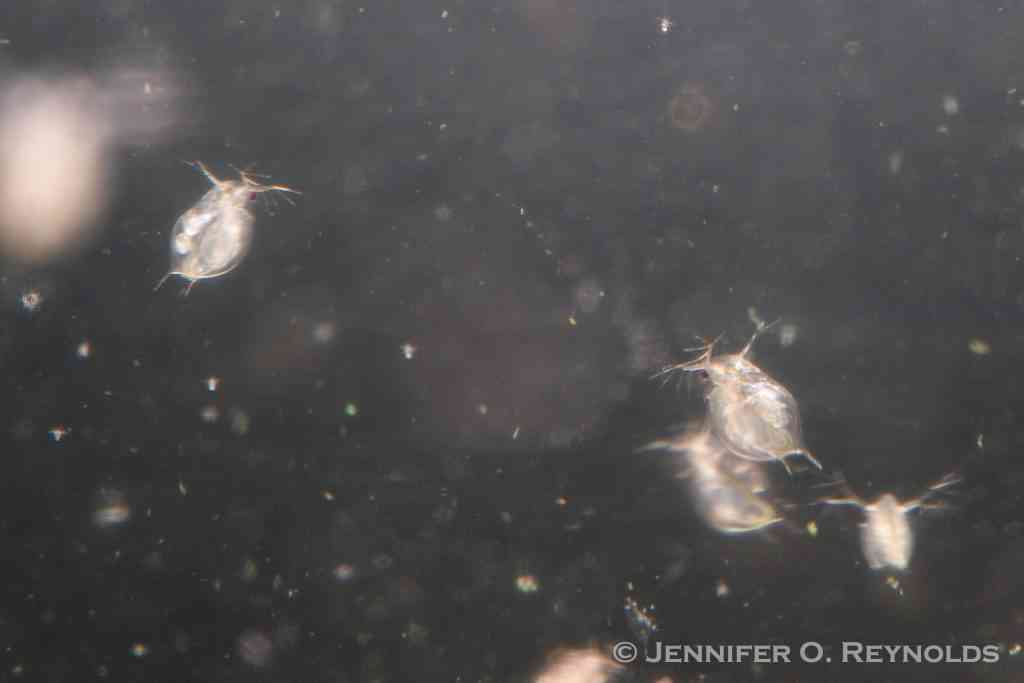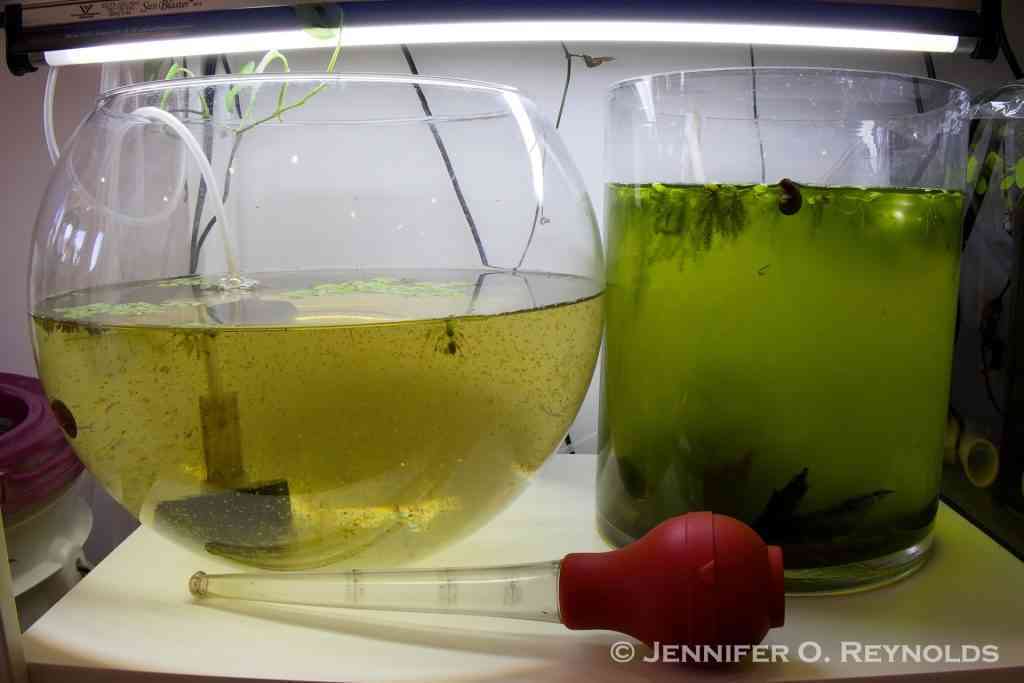Jennifer O. Reynolds, M.A. & Nora Hickey, D.V.M.
Jen and Nora discuss the benefits of feeding your aquarium fish live foods, including behavioral enrichment, nutrition, and how to set up your own home cultures of Daphnia and green water.

Nora: Jen, you have been becoming quite the live food culturist to feed your wild betta habit. You have Daphnia, scuds, microworms, baby brine shrimp, and I don’t know what else! I am so jealous of all the live foods you have that are growing so well—I have never had success with anything other than vinegar eels. I propose that in this week’s conversation, you share the secrets to your live foods success!
Jen: Absolutely! You know, it’s been a funny journey to my current enthusiasm for live foods for my aquarium fish. When I worked at the Vancouver Aquarium, it was impractical to have live foods going because of the industrial scale at which we were fishkeeping, except for tall towers of baby brine shrimp (Artemia nauplii) we hatched out daily. Culturing live foods is different from hatching artemia though. And I’m doing this in a small area of my townhouse. I think that as a professional aquarist caring for thousands of fish with different needs, I was very focused on the ease of commercially prepared and frozen foods, and they were necessary to feed so many fish. These still have an important role; it is ideal to have fish that can be adaptable. But since I decided that the fish I am most interested in keeping now are wild bettas, there is just no way around the live food piece for success. I connected with a local supplier who provides cultures and got grindal worms, microworms, scuds, and Daphnia starter cultures. I remember at the time laughing to him when I picked them up, saying “I hate live foods”, and my attitude now couldn’t be more different!
Nora: What changed your mind and has made you like them (besides your incredible success)?
Jen: There are many reasons for my attitude shift. First of all, I love fish behavior and want my fish to experience their aquarium environment as naturally as possible given the constraints. Watching my fish react to and hunt small live foods helped me see that it is an important form of enrichment for them. Enrichment in the zoo and aquarium community means giving species-appropriate challenges, opportunities and stimulation that focus on expressing natural behaviors. Most fish spend a great deal of their day in the wild searching for food, and using live foods in an aquarium can help simulate that.
Nora: What a great point! You think about hiding food or making it challenging for them to access, but I haven’t thought about presenting that type of challenge and enrichment to fish via live food.
Jen: There are definitely ways to bring an enrichment component to prepared foods (for example, adding par-boiled vegetables for plecos to graze on and work away at, instead of a higher-calorie wafer that gets eaten quickly), and this will be a great topic to cover in depth in a future conversation. But the other piece that is funny for me personally is that there is a challenge to culturing these live foods. And I think that as aquarists become more advanced, we take a certain pride in being able to grow and culture different fish species. Well, for me, my aquarist pride kicked in right after my first Daphnia crash. I thought come on now, I can breed rare freshwater tiger stingrays but can’t keep a tank of Daphnia alive? No way. I’ll figure this out. Then it was game on for me and Daphnia.
Nora: Ha! It seems like maybe the Daphnia has been your favorite so far, then?

Jen: The Daphnia have been a truly pleasant surprise, and I’m sure the wild bettas would agree with that. Two fins up from them. It’s a versatile live food. They’re also called “water fleas” as a common name because of their jerky swimming movements similar to the jumping of land fleas. This movement is particularly appealing to the predatory instincts of our fish.
My larger cichlids like Xenotilapia will eat Daphnia, and the smallest wild bettas, the Betta sp. ‘api api’, have done incredibly well with it as a staple diet. I’ve just seen these fish thriving, spawning, very active, richly colored, and so far, I’ve had no disease issues (knock on wood). I have to conclude that a healthy and natural diet is contributing to this success. One thing I have learned with Daphnia that I always keep in mind since the first crash—which is common in Daphnia cultures—is, “use it or lose it”. You can’t hoard Daphnia. You’ve got to be harvesting and feeding it when you are seeing your population boom, especially if you’re using small vessels for culture like I am.
Nora: The Daphnia has intrigued me. I remember a science project as a kid where I had to culture it, but not for very long. You have had your Daphnia culture going for months!
I will put in a quick plug for frozen foods here since I was surprised to see frozen Daphnia for fish available at my local aquarium store. This superfood is available even if you aren’t ready to commit to maintaining live cultures!
So Jen, for a complete live food novice like me, what do I need to get a Daphnia culture going?
Jen: It’s fairly straightforward. A glass vessel of 2-5 gallons will work well to hold the culture. You can use a bucket outside, but for indoors, I think it is nicer to be able to see the little guys. Room temperature or cooler is fine. Daphnia do not need or want warm water. Optional is using a small airline in it. I do not recommend airstones. The bubbles can become trapped under the Daphnia‘s carapace and cause them to float and die. A plain airline, or using a very small fine sponge filter bubbling less than two bubbles per second can help to drive off carbon dioxide and mitigate crashes.
You’ll need a starter Daphnia population. Mine are Daphnia magna. If you can’t get one locally from fellow hobbyists, you can consider a wild collection from a pond, or ordering Moina eggs online. Moina are a smaller organism in the same order as Daphnia that can be excellent for baby fish and very small species that require live foods such as the licorice gouramis (Parosphromenus spp.).
Then, what do water fleas eat? Daphnia and Moina are filter feeders that feed on suspended algae, bacteria and other plankton smaller than them using their leaf-like legs (called phylopods) which function as a filtering apparatus. A green water culture (typically this is Chlorella algae) is the best choice. I happened to luck out and accidentally grow green water in my scud culture, so I started purposefully using and maintaining it for the Daphnia. I’ve seen more success since using this, which may be because it doesn’t foul the water as quickly and is a very nutritious, natural food source. However, it can be difficult to maintain this, and if my Daphnia population is booming, I run the risk of depleting my precious green water culture. So what I do is I alternate and use green water when it’s rich and green and I can harvest from it, and when I need to give it a break to regenerate for a few days, I feed the Daphnia a mix of dried Chlorella algae I purchased, and bakers yeast. I mix this up in a small plastic dip container by adding a couple pinches of Chlorella powder, mixing it with warm water, and then sprinkling some yeast on top. Once it dissolves, I add enough of this to the Daphnia culture to make it cloudy—such that I can’t see the bottom easily. What I find is that the Daphnia will clear this out within 1-2 days depending on how concentrated the culture is. Once it has cleared or nearly cleared, the daphnia will have nutritious substances in their guts which are also good for your fish, and that is usually when I will take a fine net—brine shrimp nets work very well, but you can also try one with a slightly larger mesh size—and scoop out a serving to feed to my fish. I then feed the daphnia again after this. This system has worked very well for me.

My regime now is to water change weekly, by using a piece of airline tubing to siphon out accumulated waste (much of which is generated by the one ramshorn snail I’ve put in the culture vessel, which I also recommend). Then I feed off any Daphnia I’ve sucked out and top up their vessel with water from one of my other aquariums or from the green water culture throughout the week.
Nora: This is so detailed! I feel like I could do this. Could I use water from one of my fish tanks that has turned into pea soup to start a green water culture?
Jen: You totally could and should! I’ve never loved algae more than I do now that I am culturing Daphnia.
Nora: Yes, usually algae is something the aquarist is in a constant battle against! For someone who doesn’t have a spontaneously generating green water culture, how does someone start one?
Jen: Once again, other local hobbyists or your local fish store would be my first stop in trying to get a green water culture. You can also look for stores or online suppliers that carry it–they’re out there! The reason your tanks might have turned into pea soup is that the algae responsible for “green water” are very common in aquariums. If algae have adequate nitrogen and phosphate, strong light, and nothing eating them, they grow rapidly. A good first shot would be to take a bucket of tank water, put it in a glass jar with a lightly bubbling airline, and place it under a strong light. I use a T5 fluorescent bulb. LED lights, if strong, may work too. The more light the better, for algae. You can also add aquarium plant fertilizer.
I use Aquarium Co-op’s Easy Green liquid fertilizer for my plants, and I also provide nutrients to my green water culture by putting generous doses of this in every few days, when it’s looking weak. When I started harvesting my green water, initially I was replacing the water I’d removed with dechlorinated tap water. The culture became less and less rich and started becoming weaker. I realized I was depleting the algae of the needed nitrates and phosphates to grow by putting in new water. So now I replace the green water I remove with water from one of my aquariums where there is bound to be some of these algae-promoting nutrients present. Then I add fertilizer as needed.
Nora: This is super helpful information, I have always been very unsure of how to start and maintain even the simplest live food cultures like algae.
You mentioned a few fish you have that are loving the Daphnia, especially the wild bettas. What are some other fish that would enjoy Daphnia?
Jen: All my small rasboras and danios eat it with zeal. The pea puffer I have also relishes the Daphnia. Basically, any freshwater aquarium fish that can swim midwater where the Daphnia tend to be, whose mouth is the correct size to eat it could benefit from this food.

Other fish that come to mind for me include livebearers such as swordtails, and small cichlids such as Apistogramma spp. or shelldwellers like Neolamprologus multifasciatus. As I mentioned earlier, my Xenotilapia flavipinnis, despite being 3”+ fish, are able to eat this small food because they are sand-sifters who have evolved to filter small particles from the sand to eat. There are some larger filter-feeding cichlids such as Chaetobranchopsis, or neotropical geophagines like Satanoperca that specialize in small food items like Daphnia, so the size of your fish isn’t as much of an indicator as what their natural trophic niche and feeding behaviours are.
The exception would be mbuna; it isn’t recommended to feed high-protein foods like Daphnia to them. Plecos might grab a stray Daphnia here or there but aren’t adapted to eat this type of prey. I believe Corydoras can benefit from the food but would not be as adept at catching it. They might be able to eat some that end up on the bottom.
Nora: I think I have some fish that would enjoy this.
Jen: I’m sure you do! I’m going to send you home with a starter Daphnia culture the next time you’re here. They’re quite interesting critters. One fact I stumbled upon was related to a difference I noticed between one culture I had with an airline in it and one where I had no airline. For some reason, the Daphnia in the jar with no airline were quite red, but the ones in my main culture with an airline were clear-bodied. With a bit of digging, I learned that in lower oxygen environments they adapt to produce more hemoglobin as compensation. I found it remarkable to see this difference emerge between my two cultures here at home. There is so much more I could say about Daphnia biology which I find fascinating, but for today let’s keep it simple and encourage our readers to take a crack at this kind of live food culture. Your fish will thank you, and as a bonus, it can be economical too.
Nora: You have inspired me with your simple methods and detailed instructions—I am ready to enrich my fish’s diets and lives with Daphnia!
Reputable Resources:
The Fish Guy’s Place – Paul has excellent and detailed information about culturing live foods for fish on his website.

